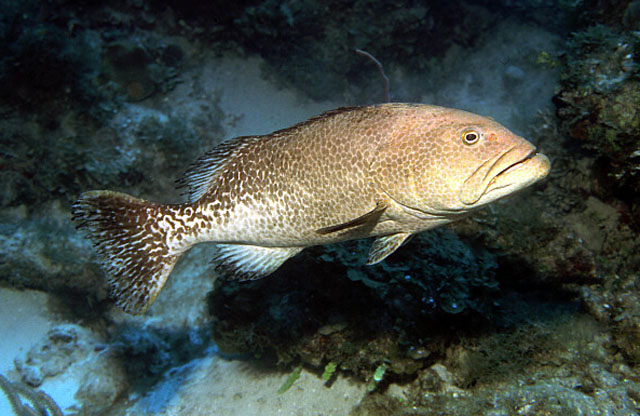| Epinephelidae (Groupers) |
| 101 cm TL (male/unsexed); max.weight: 10,000.0 g |
|
reef-associated; marine; depth range 10 - 40 m |
| Western Atlantic: southern Florida (USA) and the Gulf of Mexico to Brazil. It was suggested that Mycteroperca tigris was a transient species in the northwestern Gulf of Mexico, but has recently become abundant on the Flower Garden Banks off Texas (Ref. 6887). |
|
Dorsal spines (total): 11-11; Dorsal soft rays (total): 15-17; Anal spines: 3-3; Anal soft rays: 11-11. Distinguished by the following characteristics: Back crossed by about 11 pale narrow lines that slope downward and forward. No other grouper in the Caribbean has the same pattern of narrow pale diagonal lines (Ref. 26938). Further characterized by having depth of body contained 3.1-3.6 times in SL; head length 2.5-2.8 times in SL; flat interorbital area; rounded preopercle, without lobe at angle; diameter of posterior nostrils 3-5 times larger than anterior ones; large teeth, well developed canines (Ref. 89707). |
| A solitary species (Ref. 26340) occurring in coral reefs and rocky areas. It is considered an ambush predator that hides among the coral and sponges and is easy to approach. Frequents cleaning stations (Ref. 9710). The size versus sex distribution of Bermuda population indicates that this species is a protogynous hermaphrodite; all fish less than 37 cm TL were females and all fish larger than 45 cm TL were males (Ref. 6886). Randall (Ref. 33) reported food of 59 specimens 15 to 57 cm SL were purely fishes of a variety of species. |
|
Data deficient (DD); Date assessed: 21 November 2016 Ref. (130435)
|
| reports of ciguatera poisoning |
Source and more info: www.fishbase.org. For personal, classroom, and other internal use only. Not for publication.
